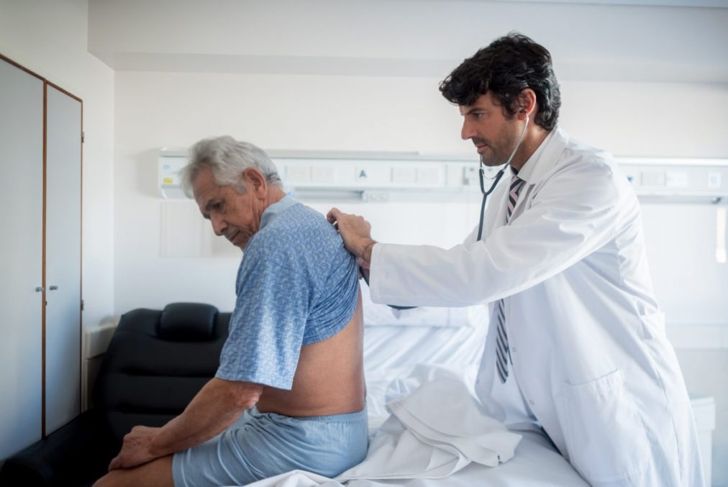Myasthenia gravis is a rare neuromuscular condition caused by poor communication between nerve endings and muscle fibers, which presents with muscle fatigue and weakness. Unlike some other neuromuscular disorders, myasthenia gravis affects only voluntary muscles or those a person chooses to move, as opposed to those that operate on their own, unconsciously. The symptoms of this disorder can vary dramatically depending on specific muscles or muscle groups it affects.
Muscle Weakness
Every symptom of myasthenia gravis stems from weakened voluntary muscles, which occurs when the immune system attacks the areas where nerve endings connect with muscle fibers. This weakens the signal that tells the muscle to contract. Therefore, people with myasthenia gravis experience weakness. The symptom can be subtle enough that a person may not realize they have a serious disorder. Symptoms usually improve after rest, causing the weakness to come and go throughout the day.
Eyelid Drooping
In over half of people with myasthenia gravis, the first symptoms develop in or around the eyes, resulting in some degree of drooping in one or both eyes. This issue, ptosis, varies from person to person, with the eyelid drooping slightly or falling so much that it covers the pupil. Ptosis can severely limit or completely block vision.
Vision Issues
Another symptom of myasthenia gravis that affects the eyes is diplopia or double vision. Diplopia can affect one or both eyes — monocular or binocular — and occurs because myasthenia gravis weakens the muscles that control eye movements, making each eye see a slightly different image. The symptoms typically improve temporarily when a person closes one eye.
Impaired Speaking
Around 15% of people with myasthenia gravis first experience symptoms in the face and throat. Because these are incredibly important muscles, the effects are more dramatic than when the condition affects other areas. One of the most common symptoms is impaired speaking. Less severe cases may cause the voice to soften or sound nasal, while more serious incidents prevent a person from making certain sounds. If the disorder weakens entire groups of muscles along the mouth and throat, speaking may become nearly impossible.
Chewing Issues
An individual with myasthenia gravis may find that certain muscles become nearly unusable as the day goes on. As he uses his muscles, they weaken at a much faster rate than in a healthy person. This is particularly noticeable while eating. Many people report losing the ability to chew halfway through a meal, especially if the food is difficult to chew, such as steak.
Difficulty Swallowing
Swallowing is normally an instinctual and easy action, and muscle weakness that affects this process can be dangerous by making choking significantly more likely. It is common for those with myasthenia gravis to expel liquids from their nose rather than swallowing them. Difficulty swallowing severely limits treatment options for myasthenia gravis and other existing conditions because taking pills becomes risky.
Breathing Difficulties
Though myasthenia gravis usually affects specific muscles, it can impact entire muscle groups. Weakening of the muscles within the chest wall is one of the most dangerous because these muscles are in constant use, prone to tiring quickly in those with the disease. As the chest wall muscles weaken, breathing becomes significantly more difficult. Over time, the body may not receive enough oxygen, which leads to dangerous complications, including organ failure and death.
Trouble Walking
Though the face and throat are most common, myasthenia gravis can affect any of the voluntary muscles, including those in the arms and legs. Depending on the severity, this can impact walking. Symptoms may first manifest as an odd gait. Eventually, even short walks can tire the muscles to the point where the individual collapses. The exact rate at which the muscles tire varies greatly with each case, making symptom prediction almost impossible.
Symptom Progression
Once the symptoms of myasthenia gravis begin, they often steadily worsen over days or weeks. Some people find their symptoms are constant throughout the day, though most fluctuate. The more someone uses their muscles, the more likely they are to experience weakness. Difficulty breathing and swallowing, as well as the risk of falls, make the condition potentially life-threatening.
Signs of an Emergency
As symptoms progress, people with myasthenia gravis become more likely to have a myasthenic crisis, a term doctors use to describe a medical emergency resulting from weakened breathing muscles. People who experience a myasthenic crisis require a ventilator. Between 15 and 20% of people with the condition experience this event at some point.

 Home
Home Health
Health Diet & Nutrition
Diet & Nutrition Living Well
Living Well More
More




















